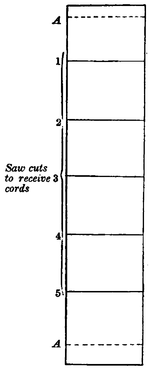if the spaces were all equal in width, the bottom one would appear to be the smallest, although accurately of the same width as the rest. This curious 
A. Saw marks for catch-up stitch. effect may be tested on any framed or mounted print. A square is now to be laid upon the back exactly to the marks, and marked pretty black with a lead pencil; the head and tail must now be sawn in to imbed the chain of the kettle stitch, at a distance sufficient to prevent the thread being divided by accident in cutting. In flexible work great accuracy is absolutely necessary throughout the whole of the work, especially in the marking up, as the form of the bands will be visible when covered. It will be easily seen if the book has been knocked up straight by laying the square at the head when the book is in the press, and if it is not straight, it must be taken out and corrected. If the book is very small, as for instance a small prayer book, it is usually marked up for five bands, but only sewed on three; the other two being fastened on as false bands when the book is ready for covering. There would be no gain in strength by sewing a small book on fine bands.
When the book is to be "sawn in," it is marked up as for flexible work, but the back is sawn, both for the bands and kettle stitch, with a tennon saw. In choosing the saw, it should be one with the teeth not spread out too much; and it is advisable to have two of different widths. Care must be taken that the saw does not enter too deeply, and one
